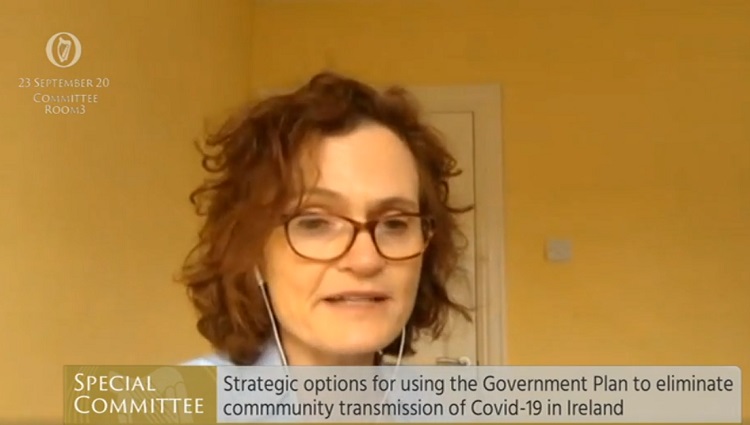Greater transparency over COVID-19 restrictions needed to encourage 'buy-in' from young people, Oireachtas committee hears
Posted 24 September, 2020

Professor Kirsten Schaffer, Clinical Professor at University College Dublin, President of the Irish Society of Clinical Microbiology, and consultant microbiologist at St Vincent's University Hospital addressing the Oireachtas Special Committee on Covid-19 Response
A lack of transparency over COVID-19 restrictions is creating division within Irish society, an Oireachtas committee has heard.
Addressing the Special Committee on COVID-19 Response (opens in a new window)Professor Kirsten Schaffer, President of the Irish Society of Clinical Microbiology, warned “buy-in” to the ongoing pandemic recommendations could decrease among young people due to them viewing COVID-19 in “abstract terms”.
“[In] a lot of European countries the rates have gone up in the past 14 days. This is mostly due to household parties, social gatherings and family get-togethers where people do not adhere to social distancing,” said the Clinical Professor at University College Dublin.
“That is why I think we have to be really careful as a society because for young people Covid-19 is quite an abstract term and they feel quite deprived of their social interactions. If we want buy-in from the whole of society to get through this difficult time, we really have to change our approach and become more open and transparent, because otherwise we will lose buy-in, especially from the younger generations because they have just had enough; they are tired of this.”
She added: “On the other side then we have the elderly and the vulnerable who are terrified. Society seems to be diverging into two directions here and that is why we really have to try to change tack a little bit to try to bring society together again.”
The expert from the UCD School of Medicine, and consultant microbiologist at St Vincent's University Hospital, told the Committee on COVID-19 Response that more epidemiology information should be made available to the public, including where outbreaks had occurred.
“We must be open and transparent so people can understand from where the recommendations come,” she said, adding that the goal for the Government should be to keep community transmission low enough to allow hospitals to function at full capacity, protect the vulnerable and permit as much economic and social life as possible.
“We now know far more about how the virus is transmitted, so we can give better advice for the elderly and vulnerable on how they can protect each other. This is really around social distancing, wearing masks, staying away from large gatherings and being careful when coming in contact with other people. This is how we should try to protect them.”
Professor Schaffer stressed that there was now a much better understanding of transmission of COVID-19 in hospitals and nursing homes, and that much better infection prevention and control measures in place than during the first wave in March and April.
Ahead of her appearance at the Oireachtas Committee, Professor Schaffer (opens in a new window)published a new paper investigating how the virus was transaminated to patients who acquired COVID-19 in hospital during this period.
Researchers from UCD and St Vincent’s University Hospital used advanced sequencing technologies to characterise 52 complete samples of the virus, isolated from patients and healthcare workers, and were able to trace the transmission routes of the virus in hospital,
The study, (opens in a new window)published in the journal Clinical Infectious Diseases, revealed that COVID-19 transmission can occur in pre-symptomatic or asymptomatic individuals, generally by close contact.
“During the first wave of the COVID-19 pandemic in March and April 2020 in Ireland, outbreaks of the virus in healthcare institutions posed a significant problem,” said Professor Shaffer, joint-lead author.
“So in this study we used genome sequencing of the SARS-CoV-2 genome to learn about the transmission routes of the virus in hospital acquired cases of COVID-19 and to decide on the appropriate infection control measures to prevent this from happening.”
“Whole Genome Sequencing allowed us to have a clear picture of the genetic material of the virus and to describe the route of transmission,” added fellow lead author (opens in a new window)Dr Guerrino Macori, a Bioinformatician from the UCD School of Public Health, Physiotherapy and Sports Science.
The study highlights that the following interventions are required to curb COVID-19 transmission in hospitals:
- Comprehensive screening of healthcare workers for COVID-19 symptoms.
- PCR testing to detect the presence of the virus, rather than the presence of antibodies, in asymptomatic healthcare workers upon identification of a hospital acquired case.
- Implementation of universal use of surgical masks for all clinical care, to prevent and break the chain of viral transmission.
- Close collaboration between guidance bodies and front line Infection Prevention and Control experts for developing control measures in an emergency pandemic situation caused by a virus with undefined modes of transmission.
By: David Kearns, Digital Journalist / Media Officer, UCD University Relations






